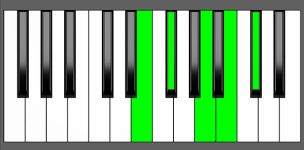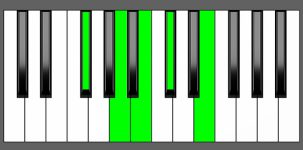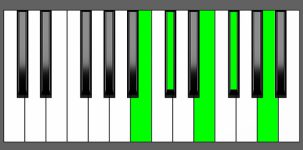Piano Diagram of A6/9 in Root Position
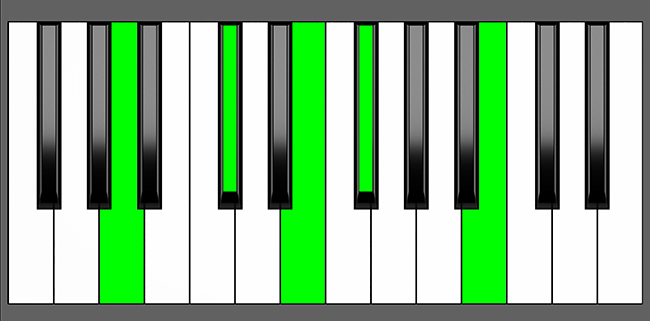
A6/9 is a five-note chord consisting of the notes A, C#, E, F#, and B. It is a major chord with an added 6th and 9th. It belongs to the chord family of 6th chords, which are “Added chords”. Keep reading to gain a deeper understanding of the music theory behind this chord.
Structure of A6/9
Notes |
|---|
| A, C#, E, F#, B |
Intervals |
|---|
| R, 3, 5, 6, 9 |
Playing Extended Chords on Piano
Extended chords are an essential part of piano playing, providing a rich and complex sound. However, playing extended chords can be challenging due to the number of notes involved. One way to manage this is by omitting certain notes, such as the root or the 5th, or by dividing the chord between both hands.
Despite these techniques, extended chords can still create dense harmonies that require careful voicing. When inverted, these chords can produce complex clusters of notes that need to be approached with skill and precision. Mastering the voicing of extended chords takes time and practice, but it’s a crucial skill for any pianist looking to expand their repertoire.
A6/9 Chord Inversions
The A6/9 chord has a total of 4 inversions:
| Root Position: | A | C# | E | F# | B |
| 1st Inversion: | C# | E | F# | A | B |
| 2nd Inversion: | E | F# | A | B | C# |
| 3rd Inversion: | F# | A | B | C# | E |
| 4th Inversion: | B | C# | E | F# | A |
Piano Keyboard Diagrams
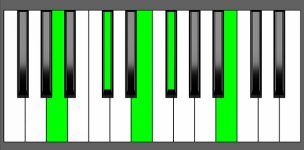
Chord Inversion on Piano
Chord inversions are a foundational concept in music theory, helping to explain how chords are built and how they fit into progressions. However, when we talk about chord inversions on a piano keyboard, it’s important to keep in mind that the diagrams we use to show the notes in an inversion might not always match up with practical playing.
In practice, pianists use different voicings and fingerings for chords, spreading the notes out across different octaves and positions on the keyboard. This means that the basic shape of a chord’s inversions as shown in diagrams might not always be the most efficient way to play the chord on a piano keyboard.
So while chord inversion diagrams can help understand the sequence of notes in a chord, they don’t always give us the best way to play the chord on a piano. It’s up to each pianist to experiment with different voicings and find the most comfortable and efficient way to play the chord while still maintaining the intended harmonic function and sound.
Music Theory and Harmony of A6/9
Building the A6/9 Chord: Different Approaches
Starting from the A Major Scale
To create a 6/9 chord, you can use the Major scale as a reference by combining a Root, a 3rd, a 5th, a 6th, and a 9th.
In this case, to build an A6/9 let’s start from the A Major scale:


Apply the formula R, 3, 5, 6, 9 to get an A6/9 chord:
- Select the Root note, which is A.
- Pick the 3rd note, which is C#, and add it to the chord.
- Add the 5th note, which is E, and include it as well.
- Now, add the 6th which is F#.
- Lastly, include the 9th note of the A Major scale, which is a B.
by Combining Intervals
To build a 6/9 chord, one approach is to combine specific intervals, namely a major 3rd, a minor 3rd, a major 2nd (whole-tone), and a major 3rd.
3 + m3 + 2 + 3 = 6/9 Chords
When constructing an A6/9 chord, you can see that
- A-C# forms a major 3rd,
- C#-E creates a minor 3rd,
- E-F# makes a whole-tone interval, and
- G-B is a major 3rd.
Stacking these intervals together creates an A6/9 chord.
How to Use A 6/9 in a Chord Progression
Since 6/9th chords are based on major triads with a sixth and a ninth added, they can substitute the major chords built on the scale of the root. This means that we can use the A6/9 chord in those positions on the scale where the harmonization makes a major chord.
In some cases, a 6/9 chord can be used as a dominant chord, but it is less common than its use as a tonic or subdominant chord.
The following tables illustrate the harmonization of scales that contain an A Maj7 or an A7 chord.
on Major Scales
| Major Scales | I | ii | iii | IV | V | vi | vii |
|---|---|---|---|---|---|---|---|
| A | A Maj7 ⇒ A6/9 | B min7 | C# min7 | D Maj7 | E7 | F# min7 | G#m7b5 |
| E | E Maj7 | F# min7 | G# min7 | A Maj7 ⇒ A6/9 | B7 | C# min7 | D#m7b5 |
| D | D Maj7 | E min7 | F# min7 | G Maj7 | A7 ⇒ A6/9 | B min7 | C#m7b5 |
- Tonic chord in A Major
- Subdominant chord in E Major
- Dominant chord in D Major (less common)
on Natural minor Scales
| Minor Scales | i | ii | III | iv | v | VI | VII |
|---|---|---|---|---|---|---|---|
| F# | F# min7 | G#m7b5 | A Maj7 ⇒ A6/9 | B min7 | C# min7 | D Maj7 | E7 |
| C# | C# min7 | D#m7b5 | E Maj7 | F# min7 | G# min7 | A Maj7 ⇒ A6/9 | B7 |
| B | B min7 | C#m7b5 | D Maj7 | E min7 | F# min7 | G Maj7 | A7 ⇒ A6/9 |
- Mediant chord in F# minor
- Submediant chord in C# minor
- Dominant chord in B minor (less common)
A6/9 Chord Function in Major and Minor Keys
Understanding Scale Degrees
When we harmonize a scale, we use the notes of the scale to create chords. This means that the notes of the chords are all found within the scale itself.
Each note in the scale is assigned a degree, which represents its position in the scale. The degrees of the harmonized diatonic major scale are as follows:
- Tonic (1st degree): serves as the tonal center or home base of the music and provides a sense of resolution and stability.
- Supertonic (2nd degree): often serves as a passing tone or a bridge between the tonic and other scale degrees.
- Mediant (3rd degree): helps to define the overall tonality of the scale (major or minor) and lies midway between the tonic and the dominant.
- Subdominant (4th degree): often used as a contrasting or complementary harmony to the dominant.
- Dominant (5th degree): creates tension and a sense of expectation, which is resolved when returning to the tonic.
- Submediant (6th degree): lies midway between the tonic and the subdominant and often serves as a bridge between the dominant and the tonic.
- Leading tone (7th degree): one half step below the tonic and creates a strong sense of tension and desire to resolve to the tonic.
A6/9 in A Major
A6/9 can be used instead of an A Maj or A Maj7 chord, which is the first chord in the harmonized A major scale.
In a major key, the I chord (built on the first degree of the major scale) serves as the tonic chord, providing the harmonic center of the chord progression.
| I | ii | iii | IV | V | vi | vii |
| A Maj7 ⇒ A6/9 | B min7 | C# min7 | D Maj7 | E7 | F# min7 | G#m7b5 |
A6/9 Chord Progressions as I degree
II V I
| ii | V | I |
| B min7 | E7 | A6/9 | A Maj7 |
I IV V
| I | IV | V |
| A6/9 | D Maj7 | E7 |
I V vi IV
| I | V | vi | IV |
| A6/9 | E7 | F# min7 | D Maj7 |
A6/9 in E Major
The A6/9 chord can also be used as the fourth degree of the E major scale as a substitute for the A Maj7. When applied to the I-IV-V progression, this chord on the fourth degree acts as a transitional chord between the first and fifth degrees.
| I | ii | iii | IV | V | vi | vii |
| E Maj7 | F# min7 | G# min7 | A Maj7 ⇒ A6/9 | B7 | C# min7 | D#m7b5 |
A6/9 as IV degree – Chord Progressions
Try playing these chord progressions to get an idea of how A6/9 functions as a substitute for the subdominant (IV degree) in a chord progression.
I IV V
| I | IV | V |
| E Maj7 | A6/9 | A Maj7 | B7 |
I V vi IV
| I | V | vi | IV |
| E Maj7 | B7 | C# min7 | A6/9 | A Maj7 |
I IV vi V
| I | IV | vi | V |
| E Maj7 | A6/9 | A Maj7 | C# min7 | B7 |
A6/9 Chord in D Major
Another (uncommon) way to use the A6/9 chord is as a substitution for the dominant chord in the D major scale. In this case, the A6/9 chord functions as a variation of the A7 chord, serving as the fifth degree of the D major scale.
When used in a ii-V-I progression, the A6/9 chord on the fifth degree can function as the dominant chord that resolves to the first degree.
| I | ii | iii | IV | V | vi | vii |
| D Maj7 | E min7 | F# min7 | G Maj7 | A7 ⇒ A6/9 | B min7 | C#m7b5 |
A6/9 as V degree – Chord Progressions
I prefer resolving the A6/9 chord to an A7 chord within the same measure, but I encourage you to explore different options and experiment with other chord progressions to see what sounds best to you.
ii V I
| ii | V | I |
| E min7 | A6/9 | A7 | D Maj7 |
I IV vi V
| I | IV | vi | V |
| D Maj7 | G Maj7 | B min 7 | A6/9 | A7 |
I IV ii V iii vi ii V
| I | IV | ii | V | iii | vi | ii | V |
| D Maj7 | G Maj7 | E min7 | A6/9 | A7 | F# min7 | B min7 | E min7 | A6/9 | A7 |
A6/9 in F# minor
Similarly, in the key of F# minor the A6/9 chord can be used as a substitute for the A Maj7 chord as the third degree.
| i | ii | III | iv | v | VI | VII |
| F# min7 | G#m7b5 | A Maj7 ⇒ A6/9 | B min7 | C# min7 | D Maj7 | E7 |
A6/9 as III degree – Chord Progressions
These chord progressions show the A6/9 chord as a substitute for the mediant (III degree) chord.
i III
| i | III |
| F# min7 | A6/9 | A Maj7 |
i III VII VI
| i | III | VII | VI |
| F# min7 | A6/9 | A Maj7 | E7 | D Maj7 |
Circle Progression
| i | iv | VII | III | VI | ii | V7 | i |
| F# min7 | B min7 | E7 | A6/9 | A Maj7 | D Maj7 | G#m7b5 | C#7 | F# min7 |
A6/9 in C# minor
Another instance where you can use an A6/9 chord instead of an A Maj7 is while playing in the key of C#. This is because the A Maj7 chord we are replacing is located on the sixth degree of the C-sharp minor scale.
| i | ii | III | iv | v | VI | VII |
| C# min7 | D#m7b5 | E Maj7 | F# min7 | G# min7 | A Maj7 ⇒ A6/9 | B7 |
A6/9 as VI degree – Chord Progressions
Try playing these chord progressions to get a sense of how an A6/9 chord can serve as an alternative to an A Maj7 chord when it functions as the submediant (VI degree) in a C# minor scale.
i VI VII
| i | VI | VII |
| C# min7 | A6/9 | A Maj7 | B7 |
i v VI VII
| i | v | VI | VII |
| C# min7 | G# min7 | A6/9 | A Maj7 | B7 |
i III VII VI
| i | III | VII | VI |
| C# min7 | E Maj7 | B7 | A6/9 | A Maj7 |
Circle Progression
| i | iv | VII | III | VI | ii | V7 | i |
| C# min7 | F# min7 | B7 | E Maj7 | A6/9 | A Maj7 | D#m7b5 | G#7 | C# min7 |
A6/9 in B minor
Using an A6/9 instead of a Major or Major 7th as the dominant chord is not so common but it is worth mentioning.
| i | ii | III | iv | v | VI | VII |
| B min7 | C#m7b5 | D Maj7 | E min7 | F# min7 | G Maj7 | A7 ⇒ A6/9 |
A6/9 as VII degree – Chord Progressions
You can try playing these chord progressions to hear how the A6/9 chord works as a substitute for the subdominant (IV degree) or you can play it with the dominant 7th chord:
i VI VII
| i | V | VII |
| B min7 | G Maj7 | A6/9 | A7 |
i v VI VII
| i | v | VI | VII |
| B min7 | F# min7 | G Maj7 | A6/9 | A7 |
i III VII VI
| i | III | VII | VI |
| B min7 | D Maj7 | A6/9 | A7 | G Maj7 |
Circle Progression
| i | iv | VII | III | VI | ii | V7 | i |
| B min7 | E min7 | A6/9 | A7 | D Maj7 | G Maj7 | C#m7b5 | F#7 | B min7 |
Alternative Names for A6/9
- A 6/9
- A 6(9)
- La 6/9
- A 6/9th
- A add6/9
Conclusion
The chord progressions and examples presented in this post provide a comprehensive overview of the most common uses of the A6/9 chord. It’s important to note, however, that many advanced harmony-related topics could not be included due to space constraints. These topics include chord progressions built on harmonic and melodic scales, modal scales, hidden tonality, secondary dominants and other chord substitutions, non-functional harmony and atonal music, modal interchange and borrowed chords, voice leading and counterpoint, chromatisms, jazz harmony…I mean, music theory is a huge topic!
Although I couldn’t cover all of these topics in my post, I encourage readers to continue exploring these areas in their study and research. By expanding your knowledge in these advanced areas of music theory, you can gain a deeper understanding of the harmonic possibilities that exist beyond the basics presented here.

